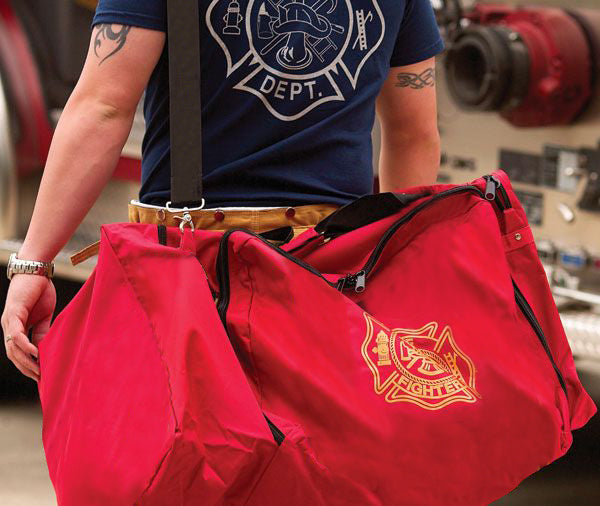Firefighter gear bags come in the form of various styles and types, including duffle bags, turnout bags, tactical bags, and customized bags. Firefighter gear bags are designed to carry and protect firefighter gear and equipment, including helmets, boots, gloves, and fire-resistant clothing.
Firefighter Gear Bags
Turnout Bags
Turnout bags are ideally designed to carry firefighter turnout gear, including helmets, coats, pants, and boots. They are made of water-resistant materials to protect the turnout gear bag from moisture and feature large compartments for easy access to gear. Turnout bags also have pockets for storing smaller items like gloves and hoods.

Duffle Bags
Duffle bags are a popular choice for firefighters because they are spacious and easy to carry. They are made of durable materials like heavy-duty nylon or PVC-coated polyester and feature multiple compartments for storage and organizing gear. Duffle bags typically have reinforced handles and shoulder straps for easy transport.
Tactical Bags
Tactical bags are designed for firefighters who need large enough to carry specialized equipment like breathing apparatus and rescue tools. They are made of tough, heavy-duty materials like ballistic nylon and have multiple compartments and pockets for organizing gear. Tactical bags often feature MOLLE webbing for attaching additional pouches and accessories.

SCBA Bag
SCBA bags are a specialized bag designed to hold a self-contained breathing apparatus (SCBA), which is used by firefighters and other emergency responders to provide breathable air in hazardous environments. The bag is large and typically made from durable materials and features compartments and straps to securely hold the SCBA unit and its associated equipment, such as face masks, air tanks, and regulators.

Customized Bags
Customized bags can be designed to meet specific needs or preferences. They can be made of different materials, colors, styles and sizes and feature a custom logo, logos or embroidery. Custom bags can be tailored to meet individual needs, including specialized compartments or pockets fit for specific gear or accessories.
How to Clean firefighter gear bags
Before cleaning the bag, remove all items inside it, including any tools or personal belongings. Use a vacuum cleaner with a brush attachment to remove loose dirt, debris, or soot from the bag. If there are any stains on the bag, spot-clean them using a gentle cleaning solution and a soft-bristled brush.
Be sure to test the cleaning solution on a small, inconspicuous area of the bag first to ensure it does not cause discoloration or damage. Using a damp cloth, wipe down the entire surface of the bag to remove any remaining dirt, dust, or debris, and rinse the bag thoroughly with clean water to remove any cleaning solution residue. Hang the bag in a well-ventilated area to air dry completely before storing it.

Note: It is important to follow the manufacturer's instructions for cleaning and maintaining firefighting gear bags, as some materials may require special care. If the firefighting helmet or firefighting gear bag itself has come into contact with hazardous materials, for example, additional cleaning methods or products may be required to ensure complete decontamination.
When to replace firefighter gear bags
According to NFPA 1851, Standard on Selection, Care, and Maintenance of Protective Ensembles for Structural Fire Fighting and Proximity Fire Fighting, gear bags should be inspected regularly for signs of damage or wear and each bag should be cleaned and disinfected as necessary. If a firefighting gear bag is found to be damaged or worn beyond repair, it should be removed from service and replaced.
The frequency of firefighter gear bag replacement depends on many factors, including the various bag type and frequency of use, the full range of conditions under which the gear bag is used, and the gear organized manufacturer's recommendations. Fire departments should follow the manufacturer's instructions for the care and maintenance of gear bags and replace them when they are no longer able to provide adequate protection for the firefighter's protective equipment.
What firefighters carry in their pockets?
Firefighters' fire gear they carry in their pockets and fire gear can vary depending on the department and the situation they are responding to, but some common items fire gear that firefighters may carry include:

Gloves
Firefighters typically carry gloves in their pockets to protect their hands when working with hot surfaces or sharp objects.
Pocket Knife
A large pocket knife can be a useful tool for a firefighter to cut through materials, tools or perform other tasks.
Flashlight
Firefighters have a small flashlight in their pocket to help them see in dark areas or in case their station or main light source fails.
Radio
Many firefighters keep a portable radio in a bag or their pocket so they can stay in touch with their team or get updates from the command post.
EMS Shears
These scissors are often the tools used by firefighters to cut clothing, seat belts or other material during a rescue operation or medical response.
Shop Enviro Safety Products for a full selection of firefighting gear bags.
Frequently Asked Question about firefighter gear bags
Q: What is a turnout gear bag?
A: Turnout gear bag are created to fit, with functionality quality, speed, and rugged durability at the forefront of their design so that you can get straight to the job saving lives without any fuss.
Q: What is the importance of firefighters' gear bags?
A: Firefighter gear bags are an essential component of firefighting equipment. They are critical to the safety and training of firefighters as well as the success of firefighting operations. Here are some details on some of these products and the reasons why firefighter gear bags are essential:
Protection
Firefighter gear bag and bags are the products designed to protect firefighting gear and equipment from damage and deterioration. Gear bag and bags are made of high-quality, durable, long-lasting materials, which resistant to withstand fire, water, and other hazards that firefighters may face on the job.
Organization
When a firefighter needs something, they can easily locate it thanks to the organization, storage and accessibility provided by firefighter gear bags.
Portability
Firefighter gear bags are of durable materials and well-designed to be portable, which is especially important for firefighters who work in rural areas or who need to travel long distances to respond to emergencies overnight.
Safety
Firefighter helmet and gear bags are reinforced and well-designed to protect firefighters from exposure to hazardous materials, such as chemicals, smoke, and other contaminants.
Comfort
Lightweight, firefighter gear bags are well-designed products with the comfort and durability of firefighters in mind. They are lightweight, and firefighter gear bags help keep firefighting equipment and gear organized and easily accessible. When a firefighter needs a specific piece of equipment, helmet or gear bag, they are often easy to carry and have padded straps and other features that help reduce the strain on firefighters' backs and shoulders.
Q: Why are they called turnouts?
A: Turnout Gear, also called Bunker Gear, was named after its historical storage in the bunks of fire departments in order that the gear could easily become visible and easily available for emergencies.
Q: What are firefighter bags made of?
A: Firefighter bags are large and typically made of heavy duty materials like nylon, canvas, or PVC-coated fabrics. They may also have waterproof zippers or other features to keep the bag and contents dry in wet conditions.
Sources
https://www.envirosafetyproducts.com/law-enforcement/bags-packs.html
https://www.envirosafetyproducts.com/the-fire-store/bags-packs.html




